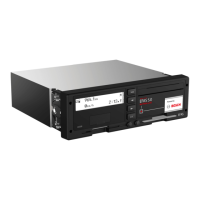45
8.11 Faulty oil-temperature measuring channel
- Check the sensor resistance:
Pin1 to pin 2 = 1005
+ 5 Ω @ 25 °C
1530
+12 Ω @ 90 °C
or check whether the fault can be remedied with a new sensor.
- Sensor OK: switch off and open the exhaust-gas analyzer.
Check the connector for continuity to the sensor board, measure the resistance. Refer to Section 8.15, "Checking the sensor board"
for the location of test points.
Check: - Connector pin 1 to X 18 (or to C43)
- Connector pin 2 to X 83, MA
- Connector pin 2 to X 16 on motherboard, MA
- Connector pin 3 to shielding panel on sensor board.
Volume resistance during all measurements < 100mΩ. If this criterion is not met, replace the sensor board as described in Section 10.9.
- Switch on the analyzer
- With the digital multimeter (DMM), check on the sensor board:
X4 (P5VREF) to X83 (MA): UDC = 5V
+ 10 mV
X 18 (or connector pin 1) to X 83 (MA): UDC = 4.60 to 4.70V.
Depending on U
REF
perform tests on/fine-tune the motherboard to Section 8.17, replace the connector to the motherboard or replace
the sensor board to Section 10.9.
8.12 Faulty O
2
measuring channel
Error messages which indicate a fault in this channel:
0FF50FF5
0FF50FF5
0FF5 During calibration, the zero window is exceeded at the O
2
amplifier output (- 10 to + 80 mV). This indicates oxygen in the
calibration gas, faulty O
2
measuring sensor or faulty O
2
amplifier.
EnPFEnPF
EnPFEnPF
EnPF When air is flowing through the exhaust-gas analyzer (system adjustment = adjustment of sensitivity of O
2
measuring channel),
a voltage threshold of 1.36 V is not reached at the O
2
amplifier output. Faulty O
2
measuring sensor or faulty O
2
amplifier.
u u
u u
u - - - O
2
amplifier signal is negative (< - 10 mV), probe connector has reversed polarity or amplifier is faulty.
If the error message "
0FF50FF5
0FF50FF5
0FF5" (zero fault) or "
EnPFEnPF
EnPFEnPF
EnPF" (sensitivity fault) appear, a new O
2
measuring sensor should always be installed
before performing any further tests. After this, the upper-range value and zero of the O
2
measuring channel must be re-defined.
Upper-range value: Press pump button, wait until system adjustment is complete.
Zero adjustment: Perform to Section 4.1.8.
If error messages still occur, open the exhaust-gas analyzer and check the O2 measuring channel.
Connect the digital multimeter to X 53 of the sensor board (reference point X 83, MA). Refer to diagram in Section 8.15, "Checking the
sensor board".
Press the pump button (system adjustment starts, air flows through the device).
Measured value at DMM (X 53) = UDC 1.36 V to 5.4 V. This measured value is achieved if the O
2
measuring sensor and amplifier are
not faulty.
Check the O
2
signal amplifier:
- Connect the DC calibrator (0...15 mV) to amplifier input X 51 (reference point MA = X 51)
- Set calibrator to 0 mV. Measured value at DMM = 0 V + 20 mV
- Set calibrator to + 15 mV. Measured value at DMM = 4.1 V + 0.2 V.
ZFor the purpose of testing, the zero and sensitivity of the O2 measuring channel can also be adjusted with the above two settings.
To do so:
- Apply + 15 mV, press the pump button, wait until system adjustment is complete
- Apply 0 mV, start zero adjustment in input mode (see Section 3.1.8).
In analysis mode (see Section 4.1.10), each intermediate value can be read on the display in O
2
% vol.
Replace defective components as appropriate.

